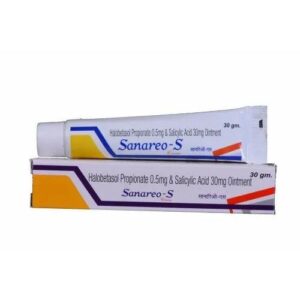SALICYCLIC ACID + HALOBETASOL PROPIONATE
Salicyclic Acid: Salicylic Acid is a drug that is used primarily for its keratolytic and anti-inflammatory properties. It is commonly used to treat various skin conditions such as acne, psoriasis, warts, and calluses.
The mechanism of action of Salicylic Acid involves its ability to exfoliate the top layer of the skin, removing dead skin cells and promoting the shedding of the outer layer. This helps to unclog pores, reduce inflammation, and improve the appearance of the skin.
Salicylic Acid is available in different formulations such as creams, gels, lotions, and ointments, with varying concentrations ranging from 0.5% to 30%. The appropriate dose and frequency of use will depend on the specific condition being treated and the severity of the symptoms. It is important to follow the instructions provided by a healthcare professional or the product label.
Potential side effects of Salicylic Acid can include skin irritation, redness, dryness, and peeling. Some individuals may also experience allergic reactions such as itching or swelling. It is recommended to start with a lower concentration and gradually increase to minimize the risk of side effects. Additionally, it is important to avoid using Salicylic Acid on broken or irritated skin, as this can increase the likelihood of adverse reactions.
It is essential to consult with a healthcare professional before using Salicylic Acid, especially if you have any known allergies, have sensitive skin, or are pregnant or breastfeeding. They can provide personalized advice and guidance based on your specific situation.
Halobetasol Propionate: Halobetasol Propionate is a potent corticosteroid medication that is primarily used topically to treat various skin conditions such as eczema, psoriasis, dermatitis, and allergic reactions.
The mechanism of action of Halobetasol Propionate is through its anti-inflammatory properties. It works by reducing redness, itching, and swelling in the affected area by inhibiting the release of inflammatory substances in the body.
This medication is available in different forms including creams, ointments, lotions, and foams. It is typically applied thinly to the affected area once or twice a day, as directed by a healthcare professional. It is important to use the medication only on the affected skin and avoid contact with eyes, lips, or broken skin.
Like other corticosteroids, Halobetasol Propionate can cause certain side effects, although they are generally rare. Common side effects may include burning, stinging, itching, or irritation at the application site. Prolonged use or excessive application can lead to skin thinning, changes in skin color, stretch marks, and increased vulnerability to infections. If these side effects occur, it is advisable to consult a healthcare professional for further guidance.
In rare cases, individuals may experience allergic reactions to Halobetasol Propionate, presenting symptoms such as rash, itching, swelling, severe dizziness, or difficulty breathing. If any of these symptoms arise, immediate medical attention should be sought.
Overall, Halobetasol Propionate is an effective medication for the management of various skin conditions. However, it is important to use it as directed and to follow up with a healthcare professional to ensure its safe and appropriate use.


